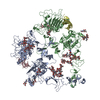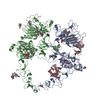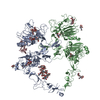+ Open data
Open data
- Basic information
Basic information
| Entry | Database: PDB / ID: 8u4k | ||||||||||||
|---|---|---|---|---|---|---|---|---|---|---|---|---|---|
| Title | Structure of the HER2/HER4/BTC Heterodimer Extracellular Domain | ||||||||||||
 Components Components |
| ||||||||||||
 Keywords Keywords | MEMBRANE PROTEIN / TRANSFERASE / Receptor Tyrosine Kinase | ||||||||||||
| Function / homology |  Function and homology information Function and homology informationestablishment of planar polarity involved in nephron morphogenesis / ERBB4 signaling pathway / ERBB4-ERBB4 signaling pathway / olfactory bulb interneuron differentiation / central nervous system morphogenesis / neuregulin receptor activity / cardiac muscle tissue regeneration / negative regulation of immature T cell proliferation in thymus / ERBB3:ERBB2 complex / ERBB2-ERBB4 signaling pathway ...establishment of planar polarity involved in nephron morphogenesis / ERBB4 signaling pathway / ERBB4-ERBB4 signaling pathway / olfactory bulb interneuron differentiation / central nervous system morphogenesis / neuregulin receptor activity / cardiac muscle tissue regeneration / negative regulation of immature T cell proliferation in thymus / ERBB3:ERBB2 complex / ERBB2-ERBB4 signaling pathway / GRB7 events in ERBB2 signaling / immature T cell proliferation in thymus / RNA polymerase I core binding / mitochondrial fragmentation involved in apoptotic process / embryonic pattern specification / GABA receptor binding / semaphorin receptor complex / PI3K events in ERBB4 signaling / positive regulation of urine volume / mammary gland epithelial cell differentiation / negative regulation of epithelial cell apoptotic process / ErbB-3 class receptor binding / regulation of microtubule-based process / positive regulation of protein localization to cell surface / Sema4D induced cell migration and growth-cone collapse / motor neuron axon guidance / neural crest cell migration / Inhibition of Signaling by Overexpressed EGFR / epidermal growth factor receptor activity / EGFR interacts with phospholipase C-gamma / epithelial cell apoptotic process / neurotransmitter receptor localization to postsynaptic specialization membrane / PLCG1 events in ERBB2 signaling / ERBB2-EGFR signaling pathway / epidermal growth factor receptor binding / positive regulation of Rho protein signal transduction / ERBB2 Activates PTK6 Signaling / neuromuscular junction development / positive regulation of transcription by RNA polymerase I / Drug-mediated inhibition of ERBB2 signaling / Resistance of ERBB2 KD mutants to trastuzumab / Resistance of ERBB2 KD mutants to sapitinib / Resistance of ERBB2 KD mutants to tesevatinib / Resistance of ERBB2 KD mutants to neratinib / Resistance of ERBB2 KD mutants to osimertinib / Resistance of ERBB2 KD mutants to afatinib / Resistance of ERBB2 KD mutants to AEE788 / Resistance of ERBB2 KD mutants to lapatinib / Drug resistance in ERBB2 TMD/JMD mutants / Signaling by EGFR / transmembrane receptor protein tyrosine kinase activator activity / enzyme-linked receptor protein signaling pathway / ERBB2-ERBB3 signaling pathway / Signaling by ERBB4 / oligodendrocyte differentiation / ERBB2 Regulates Cell Motility / positive regulation of cell division / cell surface receptor signaling pathway via JAK-STAT / Long-term potentiation / semaphorin-plexin signaling pathway / PI3K events in ERBB2 signaling / SHC1 events in ERBB4 signaling / positive regulation of protein targeting to membrane / cell fate commitment / Estrogen-dependent nuclear events downstream of ESR-membrane signaling / mammary gland alveolus development / GAB1 signalosome / regulation of angiogenesis / coreceptor activity / Schwann cell development / positive regulation of cardiac muscle cell proliferation / cell surface receptor protein tyrosine kinase signaling pathway / GABA-ergic synapse / Nuclear signaling by ERBB4 / positive regulation of tyrosine phosphorylation of STAT protein / Signaling by ERBB2 / synapse assembly / GRB2 events in EGFR signaling / SHC1 events in EGFR signaling / lactation / cellular response to epidermal growth factor stimulus / TFAP2 (AP-2) family regulates transcription of growth factors and their receptors / myelination / regulation of cell migration / Downregulation of ERBB4 signaling / GRB2 events in ERBB2 signaling / transmembrane receptor protein tyrosine kinase activity / phosphatidylinositol 3-kinase/protein kinase B signal transduction / regulation of ERK1 and ERK2 cascade / SHC1 events in ERBB2 signaling / positive regulation of cell adhesion / Downregulation of ERBB2:ERBB3 signaling / positive regulation of mitotic nuclear division / Constitutive Signaling by Overexpressed ERBB2 / neurogenesis / positive regulation of epithelial cell proliferation / basal plasma membrane / positive regulation of translation / positive regulation of cell differentiation / EGFR downregulation Similarity search - Function | ||||||||||||
| Biological species |  Homo sapiens (human) Homo sapiens (human) | ||||||||||||
| Method | ELECTRON MICROSCOPY / single particle reconstruction / cryo EM / Resolution: 4.27 Å | ||||||||||||
 Authors Authors | Trenker, R. / Diwanji, D. / Bingham, T. / Verba, K.A. / Jura, N. | ||||||||||||
| Funding support |  Germany, Germany,  United States, 3items United States, 3items
| ||||||||||||
 Citation Citation |  Journal: Elife / Year: 2024 Journal: Elife / Year: 2024Title: Structural dynamics of the active HER4 and HER2/HER4 complexes is finely tuned by different growth factors and glycosylation. Authors: Raphael Trenker / Devan Diwanji / Tanner Bingham / Kliment A Verba / Natalia Jura /  Abstract: Human Epidermal growth factor Receptor 4 (HER4 or ERBB4) carries out essential functions in the development and maintenance of the cardiovascular and nervous systems. HER4 activation is regulated by ...Human Epidermal growth factor Receptor 4 (HER4 or ERBB4) carries out essential functions in the development and maintenance of the cardiovascular and nervous systems. HER4 activation is regulated by a diverse group of extracellular ligands including the neuregulin (NRG) family and betacellulin (BTC), which promote HER4 homodimerization or heterodimerization with other HER receptors. Important cardiovascular functions of HER4 are exerted via heterodimerization with its close homolog and orphan receptor, HER2. To date structural insights into ligand-mediated HER4 activation have been limited to crystallographic studies of HER4 ectodomain homodimers in complex with NRG1β. Here, we report cryo-EM structures of near full-length HER2/HER4 heterodimers and full-length HER4 homodimers bound to NRG1β and BTC. We show that the structures of the heterodimers bound to either ligand are nearly identical and that in both cases the HER2/HER4 heterodimer interface is less dynamic than those observed in structures of HER2/EGFR and HER2/HER3 heterodimers. In contrast, structures of full-length HER4 homodimers bound to NRG1β and BTC display more large-scale dynamics mirroring states previously reported for EGFR homodimers. Our structures also reveal the presence of multiple glycan modifications within HER4 ectodomains, modeled for the first time in HER receptors, that distinctively contribute to the stabilization of HER4 homodimer interfaces over those of HER2/HER4 heterodimers. | ||||||||||||
| History |
|
- Structure visualization
Structure visualization
| Structure viewer | Molecule:  Molmil Molmil Jmol/JSmol Jmol/JSmol |
|---|
- Downloads & links
Downloads & links
- Download
Download
| PDBx/mmCIF format |  8u4k.cif.gz 8u4k.cif.gz | 452.9 KB | Display |  PDBx/mmCIF format PDBx/mmCIF format |
|---|---|---|---|---|
| PDB format |  pdb8u4k.ent.gz pdb8u4k.ent.gz | 381.2 KB | Display |  PDB format PDB format |
| PDBx/mmJSON format |  8u4k.json.gz 8u4k.json.gz | Tree view |  PDBx/mmJSON format PDBx/mmJSON format | |
| Others |  Other downloads Other downloads |
-Validation report
| Summary document |  8u4k_validation.pdf.gz 8u4k_validation.pdf.gz | 2.2 MB | Display |  wwPDB validaton report wwPDB validaton report |
|---|---|---|---|---|
| Full document |  8u4k_full_validation.pdf.gz 8u4k_full_validation.pdf.gz | 2.2 MB | Display | |
| Data in XML |  8u4k_validation.xml.gz 8u4k_validation.xml.gz | 51.8 KB | Display | |
| Data in CIF |  8u4k_validation.cif.gz 8u4k_validation.cif.gz | 78 KB | Display | |
| Arichive directory |  https://data.pdbj.org/pub/pdb/validation_reports/u4/8u4k https://data.pdbj.org/pub/pdb/validation_reports/u4/8u4k ftp://data.pdbj.org/pub/pdb/validation_reports/u4/8u4k ftp://data.pdbj.org/pub/pdb/validation_reports/u4/8u4k | HTTPS FTP |
-Related structure data
| Related structure data |  41885MC  8u4iC  8u4jC  8u4lC M: map data used to model this data C: citing same article ( |
|---|---|
| Similar structure data | Similarity search - Function & homology  F&H Search F&H Search |
- Links
Links
- Assembly
Assembly
| Deposited unit | 
|
|---|---|
| 1 |
|
- Components
Components
-Protein , 2 types, 2 molecules AB
| #1: Protein | Mass: 67909.648 Da / Num. of mol.: 1 Source method: isolated from a genetically manipulated source Source: (gene. exp.)  Homo sapiens (human) / Gene: ERBB4, HER4 / Cell line (production host): EXPI293F / Production host: Homo sapiens (human) / Gene: ERBB4, HER4 / Cell line (production host): EXPI293F / Production host:  Homo sapiens (human) Homo sapiens (human)References: UniProt: Q15303, receptor protein-tyrosine kinase |
|---|---|
| #2: Protein | Mass: 66888.008 Da / Num. of mol.: 1 Source method: isolated from a genetically manipulated source Source: (gene. exp.)  Homo sapiens (human) / Gene: ERBB2, HER2, MLN19, NEU, NGL / Cell line (production host): EXPI293F / Production host: Homo sapiens (human) / Gene: ERBB2, HER2, MLN19, NEU, NGL / Cell line (production host): EXPI293F / Production host:  Homo sapiens (human) Homo sapiens (human)References: UniProt: P04626, receptor protein-tyrosine kinase |
-Protein/peptide , 1 types, 1 molecules C
| #3: Protein/peptide | Mass: 5630.513 Da / Num. of mol.: 1 Source method: isolated from a genetically manipulated source Source: (gene. exp.)  Homo sapiens (human) / Gene: BTC / Plasmid: pET32 / Production host: Homo sapiens (human) / Gene: BTC / Plasmid: pET32 / Production host:  |
|---|
-Sugars , 6 types, 13 molecules 
| #4: Polysaccharide | alpha-D-mannopyranose-(1-3)-beta-D-mannopyranose-(1-4)-2-acetamido-2-deoxy-beta-D-glucopyranose-(1- ...alpha-D-mannopyranose-(1-3)-beta-D-mannopyranose-(1-4)-2-acetamido-2-deoxy-beta-D-glucopyranose-(1-4)-2-acetamido-2-deoxy-beta-D-glucopyranose Source method: isolated from a genetically manipulated source | ||||||
|---|---|---|---|---|---|---|---|
| #5: Polysaccharide | alpha-D-mannopyranose-(1-3)-[alpha-D-mannopyranose-(1-6)]beta-D-mannopyranose-(1-4)-2-acetamido-2- ...alpha-D-mannopyranose-(1-3)-[alpha-D-mannopyranose-(1-6)]beta-D-mannopyranose-(1-4)-2-acetamido-2-deoxy-beta-D-glucopyranose-(1-4)-2-acetamido-2-deoxy-beta-D-glucopyranose Source method: isolated from a genetically manipulated source | ||||||
| #6: Polysaccharide | beta-D-mannopyranose-(1-4)-2-acetamido-2-deoxy-beta-D-glucopyranose-(1-4)-2-acetamido-2-deoxy-beta- ...beta-D-mannopyranose-(1-4)-2-acetamido-2-deoxy-beta-D-glucopyranose-(1-4)-2-acetamido-2-deoxy-beta-D-glucopyranose Source method: isolated from a genetically manipulated source #7: Polysaccharide | alpha-D-mannopyranose-(1-6)-beta-D-mannopyranose-(1-4)-2-acetamido-2-deoxy-beta-D-glucopyranose-(1- ...alpha-D-mannopyranose-(1-6)-beta-D-mannopyranose-(1-4)-2-acetamido-2-deoxy-beta-D-glucopyranose-(1-4)-2-acetamido-2-deoxy-beta-D-glucopyranose | Source method: isolated from a genetically manipulated source #8: Polysaccharide | Source method: isolated from a genetically manipulated source #9: Sugar | |
-Details
| Has ligand of interest | N |
|---|---|
| Has protein modification | Y |
-Experimental details
-Experiment
| Experiment | Method: ELECTRON MICROSCOPY |
|---|---|
| EM experiment | Aggregation state: PARTICLE / 3D reconstruction method: single particle reconstruction |
- Sample preparation
Sample preparation
| Component | Name: Ternary complex of HER2/HER4/BTC / Type: COMPLEX Details: HER2 and HER4 Receptors were expressed in EXPI293F cells. The ligand BTC was expressed in E. coli Origami B (DE3) Entity ID: #1-#3 / Source: MULTIPLE SOURCES | ||||||||||||||||||||
|---|---|---|---|---|---|---|---|---|---|---|---|---|---|---|---|---|---|---|---|---|---|
| Molecular weight | Value: 0.284435 MDa / Experimental value: NO | ||||||||||||||||||||
| Source (natural) | Organism:  Homo sapiens (human) Homo sapiens (human) | ||||||||||||||||||||
| Source (recombinant) | Organism:  Homo sapiens (human) Homo sapiens (human) | ||||||||||||||||||||
| Buffer solution | pH: 7.4 | ||||||||||||||||||||
| Buffer component |
| ||||||||||||||||||||
| Specimen | Embedding applied: NO / Shadowing applied: NO / Staining applied: NO / Vitrification applied: YES | ||||||||||||||||||||
| Specimen support | Grid type: Quantifoil R1.2/1.3 | ||||||||||||||||||||
| Vitrification | Instrument: FEI VITROBOT MARK IV / Cryogen name: ETHANE / Humidity: 100 % / Chamber temperature: 293 K |
- Electron microscopy imaging
Electron microscopy imaging
| Experimental equipment |  Model: Titan Krios / Image courtesy: FEI Company |
|---|---|
| Microscopy | Model: TFS KRIOS |
| Electron gun | Electron source:  FIELD EMISSION GUN / Accelerating voltage: 300 kV / Illumination mode: FLOOD BEAM FIELD EMISSION GUN / Accelerating voltage: 300 kV / Illumination mode: FLOOD BEAM |
| Electron lens | Mode: BRIGHT FIELD / Nominal defocus max: 2000 nm / Nominal defocus min: 900 nm |
| Image recording | Electron dose: 45.8 e/Å2 / Film or detector model: GATAN K3 (6k x 4k) / Num. of grids imaged: 1 |
- Processing
Processing
| EM software |
| ||||||||||||||||||||||||
|---|---|---|---|---|---|---|---|---|---|---|---|---|---|---|---|---|---|---|---|---|---|---|---|---|---|
| CTF correction | Type: PHASE FLIPPING AND AMPLITUDE CORRECTION | ||||||||||||||||||||||||
| 3D reconstruction | Resolution: 4.27 Å / Resolution method: FSC 0.143 CUT-OFF / Num. of particles: 148541 / Symmetry type: POINT |
 Movie
Movie Controller
Controller






 PDBj
PDBj















